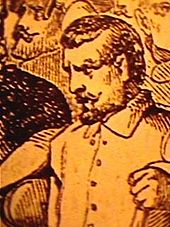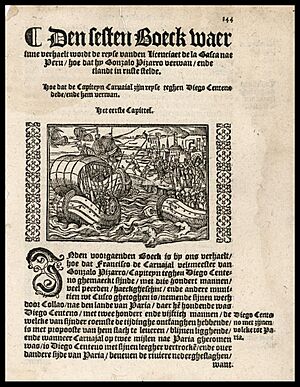Gonzalo Pizarro facts for kids
Quick facts for kids
Gonzalo Pizarro
|
|
|---|---|
 |
|
| Born | 1510 |
| Died | April 10, 1548 (aged 37–38) |
| Nationality | Spanish |
| Occupation | Conquistador |
Gonzalo Pizarro y Alonso (1510 – April 10, 1548) was a Spanish conquistador. He was the younger half-brother of Francisco Pizarro, who was famous for conquering the Inca Empire. Gonzalo was one of four Pizarro brothers who played a big part in the Spanish takeover of Peru.
Contents
Gonzalo Pizarro's Early Adventures in Peru
Gonzalo Pizarro was born in Trujillo, Spain. In 1530, he joined his oldest brother, Francisco Pizarro, on his third trip to conquer Peru. Gonzalo was also the brother of Hernando Pizarro and Juan Pizarro. He served as a leader under his brother Francisco during the conquest. Gonzalo Pizarro was known for being very strict and sometimes harsh towards the native people.
After the Inca emperor Atahualpa was captured and later executed, the Pizarro brothers and their followers marched towards the Inca capital city of Cuzco. They captured the city on November 15, 1533, after a short fight with the Inca forces. Gonzalo and his brother Juan were made leaders of the city in 1534.
Cuzco had some disagreements between the followers of Francisco Pizarro and Diego de Almagro. However, these two leaders signed an agreement in 1535. Almagro then left Cuzco. He was given the important task by King Charles I of exploring the southern part of Peru, which is now Chile.
Gonzalo and Juan Pizarro were in charge of the settlements in Cuzco. Meanwhile, their oldest brother Francisco explored the northern coast of Peru. He founded the city of Lima in 1535. Gonzalo, Juan, and their younger brother Hernándo ruled Cuzco. Their rule was sometimes unfair and they treated people very badly if they did not accept Spanish control. The Inca Emperor, Manco Inca Yupanqui, was treated with disrespect by Juan and Gonzalo Pizarro. This led to a large rebellion by the Inca people.
The Incas fought the Spanish in many battles to control their land. They even took Cuzco back for a short time on May 6, 1536. However, the Incas were later defeated by the Spanish soldiers, who were led by Gonzalo and Juan. Sadly, a disease called smallpox also spread among the native people, and many of them died.
When Almagro returned from Chile, he was disappointed because he had not found any gold. He captured and imprisoned Gonzalo and Hernándo on April 8, 1537. Gonzalo managed to escape and rejoin Francisco Pizarro. Almagro was on his way to Lima to discuss with Francisco who would control Cuzco. These discussions led to Hernándo being set free. Hernando and Gonzalo then led an army against Almagro. They defeated him in the Battle of Las Salinas. Almagro was captured and executed in Cusco on July 8, 1538.
Expeditions with Francisco de Orellana
In November 1539, Francisco Pizarro made Gonzalo the vice-governor of Quito. Quito had been taken by the Spanish in 1534. Gonzalo was told to explore the area east of Quito. He was looking for rumors of a rich native kingdom called El Dorado. He also searched for the "Land of Cinnamon." Gonzalo started getting his expedition ready in Cusco. One of the people he recruited was Francisco de Orellana. Orellana was a skilled soldier who had helped conquer the Inca.
Gonzalo left Quito in February 1541 with about 170 Spanish soldiers and 3,000 Native Americans. Orellana, who was Gonzalo's second-in-command, joined him later with more men and horses. They marched across the Andes mountains. After following the Coca and Napo rivers, the group started to run out of food. Many people died from hunger and hardship.
In February 1542, the leaders decided that Orellana would take 50 men. They would continue sailing down the Napo river to find food. Then they were supposed to return to Pizarro. However, it was impossible to sail back because of the strong river currents. Orellana also decided to continue exploring on his own.
After a while, Gonzalo realized his expedition was not going well. He decided to take a northern path back to Quito with the 80 men he had left. He did not know that Orellana would go on to discover and explore the entire Amazon River.
When Gonzalo returned to Quito, he learned sad news. His brother Francisco Pizarro had been killed on June 26, 1541. This was done by followers of Almagro, in revenge for Almagro's execution. At this time, the King's representative, Cristóbal Vaca de Castro, arrived in Peru. Gonzalo offered to help catch those who killed his brother, but his offer was refused. The Almagro followers were finally defeated in the battle of Chupas on September 16, 1542. Their leader, Diego Almagro El Mozo, was executed.
Gonzalo Turns Against the Spanish King
Later, Emperor Charles V appointed Blasco Núñez Vela as Peru's first viceroy in 1544. A viceroy is like a governor who rules a colony in the name of the king. Núñez brought in new laws called the New Laws. These laws were made to protect the native peoples. Many of the conquistadors in Peru did not like these laws. They felt they could no longer use the native people for labor.
This made Gonzalo Pizarro and Francisco de Carvajal gather an army of followers. Their goal was to stop the New Laws. Many conquistadors joined Gonzalo's side because his family name was well-known. Gonzalo's rebel army defeated Núñez in 1546 near Quito. Some people, like Carvajal, told Gonzalo to declare himself King of Peru. But Gonzalo refused to do this.
Over the next few months, Gonzalo's support began to fade. The King's new representative, Pedro de la Gasca, arrived. He offered forgiveness to those who stopped fighting and promised to change the New Laws. Most of Gonzalo's army left him just before an important battle. This was the battle of Jaquijahuana near Cusco. It would decide the future of the conquest. Without an army, Gonzalo Pizarro surrendered. He was killed by the King's forces on the battlefield. Gonzalo was the last of the Pizarro brothers to die a violent death. His brother Hernando died of old age in Spain many years later.
Images for kids
See also
 In Spanish: Gonzalo Pizarro para niños
In Spanish: Gonzalo Pizarro para niños



